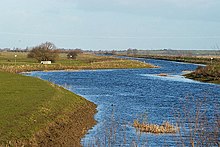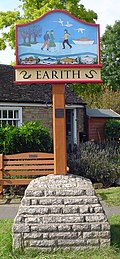Earith
| Earith | |
| Huntingdonshire | |
|---|---|
 High Street, Earith | |
| Location | |
| Grid reference: | TL373743 |
| Location: | 52°21’0"N, -0°1’12"E |
| Data | |
| Post town: | Huntingdon |
| Postcode: | PE28 |
| Dialling code: | 01487 |
| Local Government | |
Earith is a village in Huntingdonshire, in the Fenland. It stands at the very eastern edge of the county, by the boundary with Cambridgeshire; Huntingdonshire's easternmost point is just to the north of the village in the Hundred Foot Washes near the Earith Bulwark.
To the north of Earith across in Cambridgeshire is the town of Chatteris. To the west is St Ives.
Earith began as a hamlet attached to neighbouring Bluntisham and served as the inland port for the latter on the River Great Ouse. However Earith has grown and is now the equal of Bluntisham. The village lies chiefly along the road coming from Earith Bridge towards St Ives.
The name "Earith" comes from an old word which means 'mud' (or more probably gravel) and "hithe" means a landing place.
The Earith bridge has always been important. As early as 1346, the local community complained to Parliament that this bridge, which had been used from ancient times, was entirely gone for default of repair. A bridge and causeway (known as 'Earith Causey') over Haddenham Fen were looked after by hermits in the 14th and 15th centuries, and indulgences were granted around 1400 for the repairs and maintenance. This bridge was still in existence in 1637. A new bridge over the old Bedford River was erected in 1812, and a further cast-iron one was put over the new Bedford River in 1826.
Many Quakers had their homes in Earith after 1650, and a Meeting House has existed there since.
The Bedford Rivers

At Earith begin the two greatest drainage channels of the fens; the Old Bedford River and the New Bedford River. These are artificial diversion channels of the River Great Ouse and leave the river on a course to Denver Sluice near Downham Market, where they rejoin the Great Ouse.
The channels have an odd effect; the Great Ouse becomes tidal a mile or so above Earith but the tide now comes down the Old Bedford River and the New Bedford River and a sluice at Earith makes the Great Ouse non-tidal below that point, so the river is tidal for just a mile or two in the middle of its course.
Between the two channels is the strip of land known as the Hundred Foot Washes.
The village

The village has a small number of local shops, a post office, two public houses, a part-time surgery, and a school. The village does not have a parish church.
A business now occupies what was once the National School, and the Wesleyan Chapel, erected in 1828, is now a private house.
Leisure
The village is home to a marina, and during winter months ice skating is popular at nearby Bury Fen. Both activities are depicted in the village sign.
Two large lakes were formed to the north of the village during gravel quarrying in the 1960s. Today the site is home to a fishery.
History
A Roman bronze statue was found to the west of the village at Bury Fen in 1826. It is now in the British Museum.
To the North East of the village, between the Old Bedford River and the New Bedford River lies the remains of an English Civil War fort known as Earith Bulwark. It is believed to have been constructed as early as 1643, to fortify the crossing point of the River Ouse. Many fenland inhabitants resented the Royalists because they believed that the King's drainage projects undertaken by Dutch engineer Cornelius Vermuyden, had damaged their livelihoods (his Forty Foot Drain had been completed in 1637). Today, the fort is visible as a series of earthworks only, showing a square fort design with ditches and corner bastions. It is similar in design to Fort Nassau in the Netherlands. During the Second World War, a machine gun turret was built on the south bastion.[1]
In 1947, the "Battle of Earith Gap" took place. Melting snow had built up in the Fenland waterways, but the meltwater could not eacape down the Bedford Rivers into the sea because of high tides. On 17 March a 50-yard gap burst in the river bank, and water poured out to flood the Fen farms for five days. Eventually the breach was blocked with amphibious vehicles while more orthodox repair work was carried out.[2]
Transport
The village was connected to railway services in 1865, with a station located to the east of the village, in an area named Earith Bridge, on the Ely and St Ives Railway. Passenger services were discontinued in 1931, and the Earith section of railway was closed in 1958.
The long distance footpath The Ouse Valley Way links the village with Stretham (11 miles) and St Ives (6 miles).
Outside links
| ("Wikimedia Commons" has material about Earith) |
